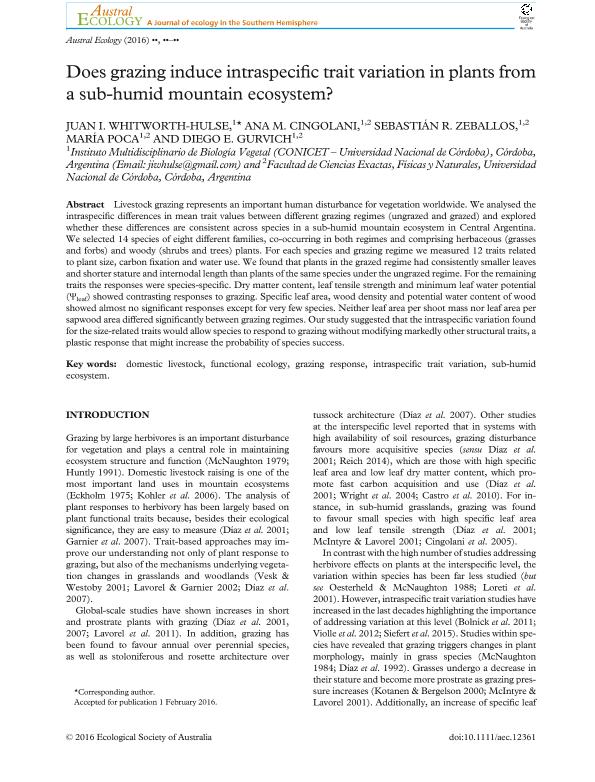Artículo
Does grazing induce intraspecific trait variation in plants from a sub-humid mountain ecosystem?
Whitworth Hulse, Juan Ignacio ; Cingolani, Ana María
; Cingolani, Ana María ; Zeballos, Sebastián Rodolfo
; Zeballos, Sebastián Rodolfo ; Poca, María
; Poca, María ; Gurvich, Diego Ezequiel
; Gurvich, Diego Ezequiel
 ; Cingolani, Ana María
; Cingolani, Ana María ; Zeballos, Sebastián Rodolfo
; Zeballos, Sebastián Rodolfo ; Poca, María
; Poca, María ; Gurvich, Diego Ezequiel
; Gurvich, Diego Ezequiel
Fecha de publicación:
11/2016
Editorial:
Wiley Blackwell Publishing, Inc
Revista:
Austral Ecology
ISSN:
1442-9985
e-ISSN:
1442-9993
Idioma:
Inglés
Tipo de recurso:
Artículo publicado
Clasificación temática:
Resumen
Livestock grazing represents an important human disturbance for vegetation worldwide. We analysed the intraspecific differences in mean trait values between different grazing regimes (ungrazed and grazed) and explored whether these differences are consistent across species in a sub-humid mountain ecosystem in Central Argentina. We selected 14 species of eight different families, co-occurring in both regimes and comprising herbaceous (grasses and forbs) and woody (shrubs and trees) plants. For each species and grazing regime we measured 12 traits related to plant size, carbon fixation and water use. We found that plants in the grazed regime had consistently smaller leaves and shorter stature and internodal length than plants of the same species under the ungrazed regime. For the remaining traits the responses were species-specific. Dry matter content, leaf tensile strength and minimum leaf water potential (Ψleaf) showed contrasting responses to grazing. Specific leaf area, wood density and potential water content of wood showed almost no significant responses except for very few species. Neither leaf area per shoot mass nor leaf area per sapwood area differed significantly between grazing regimes. Our study suggested that the intraspecific variation found for the size-related traits would allow species to respond to grazing without modifying markedly other structural traits, a plastic response that might increase the probability of species success.
Archivos asociados
Licencia
Identificadores
Colecciones
Articulos(IMBIV)
Articulos de INST.MULTIDISCIPL.DE BIOLOGIA VEGETAL (P)
Articulos de INST.MULTIDISCIPL.DE BIOLOGIA VEGETAL (P)
Citación
Whitworth Hulse, Juan Ignacio; Cingolani, Ana María; Zeballos, Sebastián Rodolfo; Poca, María; Gurvich, Diego Ezequiel; Does grazing induce intraspecific trait variation in plants from a sub-humid mountain ecosystem?; Wiley Blackwell Publishing, Inc; Austral Ecology; 41; 7; 11-2016; 745-755
Compartir
Altmétricas



